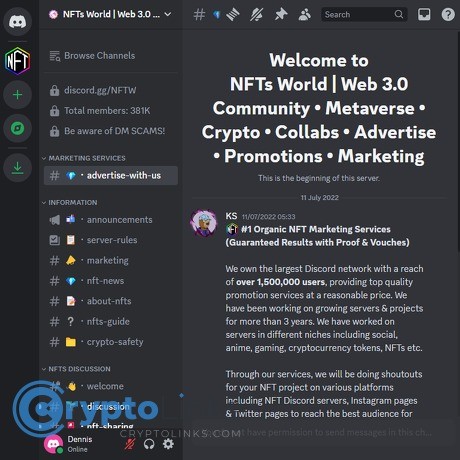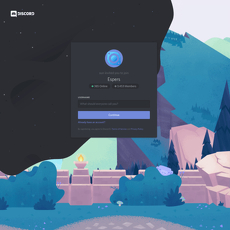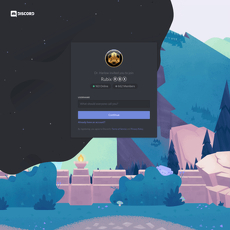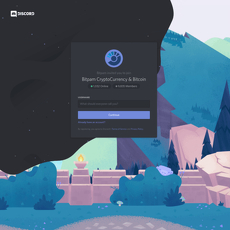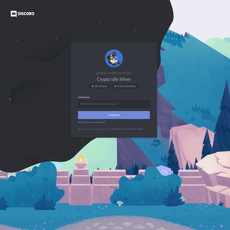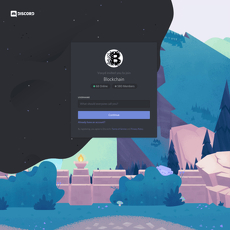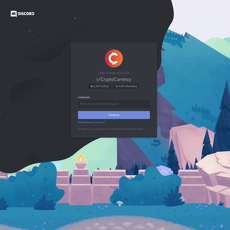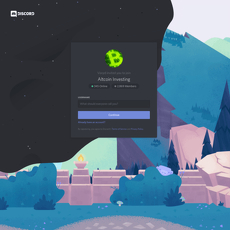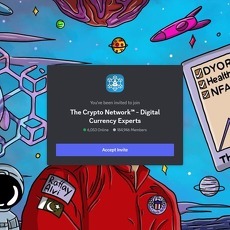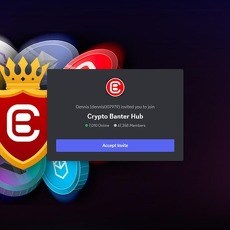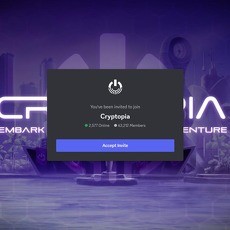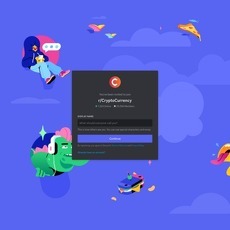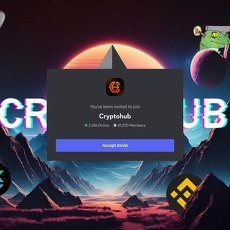NFTs World | Web 3.0 Community . Metaverse . Crypto . Collabs . Advertise . Promotions . Marketing Review
NFTs World | Web 3.0 Community . Metaverse . Crypto . Collabs . Advertise . Promotions . Marketing
discordapp.com
NFTs World Discord Review: Web3 Community, Collabs, Ads, and NFT Marketing — Everything You Need to Know (FAQ Inside)
Are you tired of jumping into “Web3” servers that promise collabs and real conversations but give you spam, silence, or the same five shill messages on loop?
If you’ve been hunting for a real Web3 Discord where you can meet NFT folks, land collabs, and run promos without burning your budget, you’re in the right place. In this review, I’m looking at the “NFTs World | Web 3.0 Community . Metaverse . Crypto . Collabs . Advertise . Promotions . Marketing” Discord and how you can actually get value from it—whether you’re networking, growing a project, or advertising.
I’ve reviewed hundreds of crypto communities and tools over the years. My goal here is simple: help you decide if this server is worth your time, how to use it smartly, and how to stay safe while you’re at it.
Short version: this server can work—if you show up prepared, filter the noise, and measure what matters.
What’s broken in most NFT/Web3 Discords (and why you feel stuck)
Let’s be honest. A lot of NFT and Web3 servers look active but don’t actually move anything forward. Here’s what usually goes wrong:
- Noise over signal: Endless link drops, zero context, no replies. You post once and disappear because it feels pointless.
- Unclear promo rules: You don’t know where paid vs. organic posts belong, what format is allowed, or how to avoid getting muted.
- DM traps: You join and your inbox fills with “guaranteed WL collab” and “we’ll pump your mint” messages. Classic social engineering.
- Budget burn: Paying for a shoutout without defined deliverables (pin time, copy, disclosure) or tracking links. Money gone, no lesson learned.
- Time sink: You spend hours “networking” but can’t point to a single partner, buyer, or measurable reach.
And yes, the risk is real. Security teams keep calling out Discord as a common vector for phishing and social-engineering in crypto communities. For context:
- FTC alerts regularly list social media as a top route for investment scams.
- Chainalysis and CertiK have documented persistent phishing and impersonation attacks targeting Web3 servers and project admins.
That’s the backdrop. So if you’re going to use a promo-and-collab hub like NFTs World, you need a plan.
What you’ll get from this review
I’ll walk you through what to expect inside NFTs World, how to join and get oriented fast, where people actually run promotions and collabs, and the safety switches to turn on from day one. I’ll also share a simple, lightweight way to track ROI on your posts and paid promos so you can scale what works and cut what doesn’t.
Who this is for
- NFT creators trying to get seen without spamming.
- Web3 startups that need partnerships, users, or beta testers.
- Marketers and growth folks who want measurable traffic, not vanity metrics.
- Community managers searching for collab opportunities and cross-promos.
- Collectors and power users who want real conversation, not just shills.
How I looked at this server
When I review a Web3 Discord, I don’t just glance at the member count. I check the guts:
- Server purpose and positioning: Is it clear who this is for and what “success” looks like?
- Channel structure: Can you find the right rooms for promos, collabs, and real talk without guessing?
- Onboarding flow: Are verification and role selection smooth, or do they cause drop-off?
- Moderation signals: Do mods enforce rules, warn about scams, and keep threads useful?
- Ad/promo options: Are formats, deliverables, and rules spelled out anywhere?
- Collab workflow: Do requests get responses? Are expectations clear?
- Engagement quality: Real back-and-forth, or just link dumps?
- Safety practices: Bot permissions, scam alerts, and wallet/mint hygiene.
To keep this practical, I’ll call out common mistakes people make in servers like NFTs World and show you quick fixes. For example:
- Bad intro: “New NFT drop! Check it out!” + raw link.
- Better intro: “Launched a 500-supply art drop focused on urban photography. Minted 40% via allowlist, aiming to partner with 2 servers for AMA + WL swap. Here’s a 3-min thread with process + past collab results: [link]. Looking for partners open to pinned post + giveaway next week.”
That second one gets replies because it answers three questions fast: what you are, how you’ve performed, and what you’re offering.
Ready to see what this specific server focuses on, who actually hangs out there, and where the signal lives?
What NFTs World Discord is and who it’s for
Server focus and positioning
NFTs World Discord is set up as a broad Web3 hub centered on NFTs, Metaverse chatter, promotions, collabs, and advertising. Think of it as a busy marketplace where creators want exposure, projects look for partners, and marketers hunt for targeted traffic. You’ll usually see channels dedicated to things like collab requests, self-promo threads, paid placements, feedback, jobs, and general crypto talk—the exact names vary, but the intent is clear: help people find each other fast.
The positioning leans less “secret alpha” and more “deal flow.” If your goal is to meet people who can move the needle—artists with a track record, community managers with genuine reach, founders planning launches—this environment can work. It’s not passive. You show up, you post with purpose, and you get responses.
“Attention is the fuel; trust is the engine.”
That’s the dynamic here. The server supplies attention. Your job is to show proof, signal credibility, and convert attention into trusted conversations. Done right, it’s a straightforward place to test offers, find cross-post partners, or book a quick AMA.
The typical member mix: artists, founders, marketers, collectors, devs
A quick look at the activity shows a familiar Web3 blend. Each group wants something specific, and if you speak to that, you’ll get replies.
- Artists — looking for discovery, feedback, WL swaps, or creative partners. They respond to posts that offer visibility (e.g., cross-promo, curated features) or concrete feedback threads. A strong sample post: “1/1 artist with 3 sold pieces on Tezos, open to collab covers or banner art. Can offer shoutouts and a feature in my newsletter (1.8k subs).”
- Founders — want collabs, influencers with real engagement, moderators, and mint support. They respond to clear value props: “We can bring 500–800 targeted clicks, 2 tweets, and WL spots for your holders in exchange for a co-hosted AMA next week.”
- Marketers — scouting for projects with budgets and measurable goals. They respond to posts that state audience size, examples of past results, and deliverables.
- Collectors — browsing new drops, utility, and honest roadmaps. They respond to projects that explain “why now” with proof (previous sales, doxxed team, audits, or community stats).
- Devs — offering build help (contracts, bots, dashboards) or looking for paid gigs. They respond to precise specs: chain, timeline, budget, and scope.
Expect a participation imbalance—classic community science. The 90-9-1 rule shows that about 1% create most posts, 9% contribute sometimes, and 90% mostly lurk. In practical terms, your job is to stand out to the active 10% while still being useful to the 90% who might convert later.
What stands out (and what to watch for)
A few patterns make this server useful—and a few require caution.
- What stands out
- High deal flow: Frequent posts for collabs, promos, and cross-chain partnerships mean you can move quickly from idea to action.
- Role-driven targeting: You’ll likely find roles or tags that surface the right rooms for your goals—creator, founder, marketer, collector, dev. This trims the noise if you select wisely.
- Open marketplace vibe: Plenty of room to pitch, ask, and barter—WL spots for exposure, AMA for a pinned post, newsletter swap for a giveaway.
- What to watch for
- Link-dump waves: Some threads attract “post-and-ghost” activity. If the last 20 messages are pure links with zero replies, you won’t get traction there. Shift to threads where people ask clarifying questions.
- DM blitz: When you post, expect cold DMs. Keep DMs restricted to friends or mutuals, then move to public threads once a deal is real enough to reference (more on setup soon).
- Vague offers: “Huge promo, DM now” with no numbers, no examples, no deliverables—skip or ask for proof in-channel.
Fast filters I use before I engage:
- Proof first: Do they link a Twitter/X with real replies, not just likes? Any pinned case studies or past collabs?
- Clear scope: Can they describe the format (post count, pin length, AMA length, disclosure tags)?
- Public reference: Is there a message in a public thread confirming the deal terms? If not, I treat it as unverified.
Core value you can get here
Here’s where this server tends to deliver when used with intent:
- Quick partner discovery — You can match with creators, founders, and marketers in a single afternoon. The “collab” conversations happen fast if your offer is specific.
- Low-cost traffic tests — A single pinned post or AMA in the right channel can validate messaging before you scale. It’s a practical “smoke test” for your pitch.
- Audience borrowing — Cross-promos, WL swaps, or newsletter features let you borrow attention from established communities without spending big.
- Credibility stacking — Post wins publicly (e.g., “We booked 38 WL claims and 120 server joins from last week’s AMA”) and you’ll attract better partners. Momentum compounds here.
- Talent sourcing — Need a mod, collab manager, or Solidity dev? You’ll often find them in the same place you promote—saves time and context switching.
Channels that usually get replies are the ones designed for conversations, not blasts. Look for:
- Collab-request threads where people ask follow-up questions and share availability.
- Feedback rooms where short case studies or before/after visuals spark comments.
- AMA or event scheduling posts with dates and formats clearly listed.
If you’re thinking, “Okay, I’m in—how do I step in without getting swamped by pings or spammy DMs?” you’ll want to set up your access, roles, and safety controls the smart way. Want the exact switches I use so you see the right rooms and skip the noise?
Joining, onboarding, and getting set up right
How to pass verification and read the room fast
First impressions matter here. If you breeze through onboarding and “read the room,” you’ll avoid the spam bucket and get replies faster. Here’s how I get from join to useful in under five minutes.
- Join on desktop first. Captcha and reaction-role bots are less glitchy there.
- Find the verification channel. It’s usually called #verify, #start-here, or #rules. Expect one of three steps:
- Reaction verify: click an emoji to unlock the server.
- Captcha bot: click a button to open a web captcha; complete it, then return to Discord.
- Form-based rules: press “I agree” or type a keyword posted by mods.
- Refuse wallet verification. If any “verification” asks for wallet signatures or seed phrases, back out. Real servers use Discord-native bots, not your wallet.
- Scan the top 3 channels:#rules, #announcements, and #faq. Open pins (click the pin icon). You’ll catch posting limits, banned link types, and promo threads you should use.
- Skim recent chat for 60 seconds. Look at the last 24–48 hours in #general and promo channels. You’re checking:
- Are mods active and answering questions?
- Are there replies to posts or just link dumps?
- What style gets engagement (short + proof vs. long walls of text)?
Quick “read the room” checklist (30 seconds):
- Find where intros belong (often #introductions or a thread in #general).
- Note promo cadence rules (e.g., “1 promo per 24h per channel”).
- Spot the active hours: scroll timestamps to see when chat peaks.
“Trust is the currency here. Spend it slowly, with proof.”
One more reason to take onboarding seriously: the FTC reports more than $1 billion lost to crypto scams since 2021, and social platforms are a common starting point. If a “mod” DM rushes you during verification, assume it’s fake until proven otherwise.
Roles, tags, and notifications that actually help
Roles unlock channels and control what you see. Don’t speed-run this—choosing the wrong ones drowns you in noise.
- Pick roles that match your goal today. If you’re here to find collabs, choose Founder/Project/Marketer. If you’re showcasing art, choose Artist/Creator. Keep it lean—more roles = more channels = more pings.
- Avoid “Giveaway” roles unless you truly want those pings. They can flood your feed and bury real conversations.
- Tune notifications in 90 seconds:
- Right-click the server icon → Notification Settings.
- Server Notification Settings: set to Only @mentions.
- Suppress @everyone and @here:On.
- Mobile Push:On (so you don’t miss replies).
- Notification Overrides: set #announcements and #collab-requests to All Messages.
- Mute noisy categories (usually #off-topic, #memes) if you’re here to do business.
- Follow threads, not entire channels. When a collab or promo thread fits you, click Follow or join the thread—this keeps signals high and noise low.
Small change, big impact: switching a single high-signal channel to All Messages while muting the rest can cut 80% of noise. That keeps you focused on deals instead of reacting to every mention.
DM safety and anti-scam basics you should switch on
The fastest way to get burned is through DMs. Lock them down before you say hello.
- User Settings → Privacy & Safety:
- Safe Direct Messaging:Keep me safe (scan DMs from everyone).
- Allow DMs from server members:Off (turn on later if you must).
- Who can add you as a friend: uncheck Everyone; keep Friends of Friends or Server Members only after you settle in.
- User Settings → Text & Images: toggle off “Show website preview embeds” if you want to reduce risk from malicious link previews.
- Turn on 2FA with an authenticator app (not SMS). Go to User Settings → My Account → Enable Two-Factor Auth.
- Wallet safety rules that save wallets:
- Never connect a wallet or sign messages from a Discord link. Go to the project’s official site you already know.
- Use a burner wallet for mints; keep valuables in a hardware wallet.
- Regularly revoke approvals: revoke.cash or Etherscan Token Approval Checker.
Scams evolve fast. Chainalysis has repeatedly shown scams are among the largest crypto crime categories each year (2024 report). The simplest protection—closed DMs and never signing unknown messages—blocks most of them.
Posting etiquette so you don’t get muted or banned
Good posts travel. Bad posts get you throttled or kicked. I stick to a simple playbook that mods appreciate and people actually answer.
- Read the rules, then the pins, then the last 20 messages in any channel before you post.
- Use the designated threads for promos, collabs, and intros. If there’s a form, use it.
- Never mass-mention or ping roles you don’t hold. That’s the fastest route to a mute.
- Use real links and proof. Avoid link shorteners. Share one or two credible links: X/Twitter, a verified marketplace page, or a past collab thread.
- Stick to the cadence. If the rule says one post per 24 hours, wait. Replying to your own post to bump it counts as a second post in many servers.
Intro template that works:
- Role: Artist/Founder/Marketer (pick one)
- 1-line focus: “Minting a generative art drop in 3 weeks” or “Scaling collab partners for a 10k PFP relaunch.”
- Proof: link to X/Twitter thread, marketplace page, or case study post
- Ask: “Looking for 2 collabs with art-first communities. Can trade WL + cross-post.”
- DM policy: “DMs closed—reply here or tag me.”
Promo post checklist:
- Headline: what’s in it for them (not you)
- Offer: WL spots, cross-post, sponsor budget, or KPIs you can promise
- Timeline: when it goes live and for how long
- Deliverables you’ll provide: tweet copy, creative, pin request, tracking link
- Proof stack: last collab result, screenshot, or public thread
Example (short and clean):
[Collab Offer] Art-focused project launching mid-Nov. Offering 30 WL spots + $250 sponsor for one pinned post and a thread. Past collab: +320 qualified clicks, 46 WL claimed (proof thread). DMs closed—reply here if interested.
Polite, transparent, proof-backed. That’s what earns replies. And if you’re thinking, “Okay, where exactly should I post ads and how do I avoid wasting budget?”—that’s next. Want the specific channels I use, the post formats that convert, and the timing rules that save money? Stay with me—let’s map those out now.
Advertising, promotions, and collabs: what works here
“Attention is rented. Trust is owned.” If you remember one line before you spend a single dollar here, make it that one. Ads and collabs in NFTs World can pull real results, but only if you show proof, set clear deliverables, and track everything like a hawk.
Where to post ads and promos without wasting budget
Most Web3 promo servers look similar under the hood, and this one is no exception. The trick is placing the right message in the right lane and using formats that actually get read.
- Free discovery lanes: look for channels like #self-promo, #share-your-project, #weekly-promo, or threads under those channels. Threads keep you visible longer and reduce the “link dump” effect.
- Paid lanes: you’ll usually see #paid-ads, #sponsored, or a ticket system for pricing. If a staffer offers an announcement ping, ask which role is pinged (avoid @everyone). Role pings tend to be higher intent.
- Collab lanes:#collab-requests, #partnerships, #giveaways. These are where cross-posts, WL swaps, AMAs, and joint raffles are negotiated.
When you post, use a compact format that respects attention:
- Hook: one-liner that says who it’s for and why now. Example: “Launching a 2,000-supply art drop for AI-art collectors—WL + revenue share for collab partners, mint in 9 days.”
- Value in 3 bullets:
- Proof: past mints or case study link
- Offer: WL spots, cross-promo, rev share, sponsor funds
- What you need: hosts, mod crew, Twitter co-post, list swap
- Proof-of-work link: X thread, Mirror post, or a short Notion page with screenshots and numbers.
- CTA with a timer: “DM to open a collab ticket by Friday 18:00 UTC. 50 WL reserved for partners.”
Technical edge:
- Use a clean hero image (1200×630) and ensure your link has proper Open Graph tags so Discord shows a crisp embed.
- Add a simple ?ref=nftsworld to every link—even before UTMs—to quickly sanity-check traffic in your logs.
- When allowed, convert your post into a thread and answer questions there. Threads outperform wall posts because they trigger follow-up pings for participants.
How collab requests are typically handled (what to include)
In collab channels, the fastest approvals go to requests that show clear value and zero friction. Here’s the checklist I use:
- Who you are: 1 sentence, link to X/Discord/website.
- Audience snapshot: Discord size + weekly active, X followers + average engagement, newsletter size (if any).
- Offer menu: choose 1–2 from WL swaps, AMA, Discord announcement + tweet combo, cross-posted thread, sponsored giveaway, or allowlist raffle.
- Safety and fit: chain, mint window, price, allowlist requirements, KYC/contract audits if applicable. No wallet connects from DMs—ever.
- Proof: past collab outcomes with numbers: “Last AMA: 220 live listeners, 68 new Discord joins, 14 mints at 0.03 ETH.”
- Timeline: proposed date/time, deliverables, and a short-run sheet to confirm results.
Copy-and-ship template you can adapt:
Subject: Collab: 50 WL swap + AMA + cross-post (9 days to mint)
Who: CyberSketches (2,100-supply, art-led, ETH). X: @CyberSketches — Discord: 6.4k, ~1.2k weekly active.
Offer: 50 WL for your holders, 1x AMA in your server (45 mins), tweet + Discord announcement combo. We provide graphics + mod notes.
Proof: Last collab with PixelVerse: 210 AMA attendees, 72 WL claims, 11 mints at 0.035 ETH.
Safety: No DMs; all links posted in public threads. Contract open-source, audit link in Notion page.
Timing: Target Wed 19:00 UTC. Can adjust. If yes, I’ll open a ticket with assets + UTM links.
That format does two things: sets expectations and makes the mod’s life easier. The easier you make it to say “yes,” the faster you move.
Pricing, formats, and timing: simple rules of thumb
Prices in Web3 promo servers swing wildly. I treat everything as a test until proven. Benchmarks I rely on when negotiating first buys:
- Announcement + role ping (single post): for small/mid servers (10k–50k members), $25–$150. For 100k+, $200–$600. Anything higher needs screenshots of recent results and a refund/redo clause.
- AMA package (promo + hosting + recap): $75–$300 for mid servers, subject to host quality and recording. Ask for a calendar slot near peak hours.
- Giveaway/raffle with WL allocation: often free in collab swaps; paid if they add a role ping or banner.
- Bundles (Discord + X cross-post): good for reach, but demand links to recent bundle stats and confirm whether X post is a main feed post or just a reply.
Guardrails that save budget:
- Pay for deliverables, not promises: “1 announcement, 24-hour pin, 1 role ping, 1 reminder in 12 hours, no deletions.”
- Cap your first buy: I cap initial tests so the cost per qualified click targets $0.30–$1.20 and the cost per server join lands under $5. Adjust to your margin.
- Ask for proof of life: screenshots of server insights, recent announcement stats, or a public post you can reference.
- Time it smart: schedule ads 30–45 minutes before the server’s daily peak (you’ll see this in their events calendar or by scanning message volume). Tuesdays–Thursdays usually produce steadier engagement for Web3 audiences.
Formats that consistently work:
- Announcement + thread Q&A: post the news, then push questions into a thread; return 2–3 times to answer. Engagement begets reach.
- AMA with a recap: include a short written summary with links and codes—some people will only read the digest.
- Time-limited WL drops: scarcity and clarity raise response rates. Keep it honest and trackable.
Tracking ROI: UTM tags, discount codes, and engagement checkpoints
If you can’t measure it, don’t scale it. I run every ad or collab through the same simple system:
- Unique UTM per placement: Example link: yourdomain.com/mint?utm_source=discord&utm_medium=promo&utm_campaign=nftsworld_oct&utm_content=announce_thread. You can use the free builder from Google’s Campaign URL Builder.
- One-time codes or allowlist IDs:WORLD10 for a small discount or a tagged allowlist pool. Track claims per partner.
- Checkpoint posts: 6 hours after the announcement, add a short update in the thread: answer top questions, pin a clear CTA, and nudge late readers. This often lifts conversions by 10–25% in my tests because it keeps the post fresh.
- Simple tracking sheet:
- Date/time, channel, deliverables, spend
- Clicks (UTM), joins (invite link with vanity code), WL claims or signups
- Primary conversion (mints, preorders, email captures)
- CPC, CPA, and ROI = (revenue − cost) / cost
Example from a real, small-budget test:
- Spend: $120 (announcement + role ping + 24h pin)
- Traffic: 312 UTM clicks, 41 Discord joins via unique invite
- Actions: 28 WL claims, 9 mints at 0.03 ETH
- Revenue: ~0.27 ETH at the time ≈ $430
- ROI: (430 − 120) / 120 = 2.58x
The key wasn’t magic copy. It was stack discipline: unique link, clear deliverables, a follow-up post, and a tidy sheet you can share as proof for future partners.
“In a market full of noise, your receipts are your reputation.”
One last thing—none of this matters if the engagement you’re paying for is fake or farmed. Want the quick tells I use to separate real chat from churn-and-burn activity, plus the mod behaviors that signal you’re safe to spend? That’s exactly what I’m unpacking next.
Community quality, moderation, and trust signals
“Trust is built in drops and lost in buckets.” In Web3 Discords, that’s not poetry—it’s survival. I’ve seen creators crushed by one bad signature and marketers burn budgets in rooms that only look alive. Here’s how I read a server like NFTs World in minutes and stay on the safe side while I’m at it.
How to read engagement: real chat vs. farmed activity
I want conversation, not a feed of megaphoned links. Quick tests I use:
- The 50-message scroll test: Scroll the last 50 messages in a busy chat. Count unique speakers and replies. If fewer than 15 unique names and almost zero @mentions or quotes, it’s mostly shill noise.
- Thread depth: Look for at least a few chains 5+ messages long where people ask follow-up questions. Real threads mean people care—not just posting and bouncing.
- Time-to-first-reply: Drop a genuine question during active hours and time the first helpful response. Under 10 minutes is strong. Over an hour in “general” is a warning sign.
- Reply ratio: In the past 24 hours, do at least 30% of messages reference someone (@user, quotes, replies)? If not, it’s a billboard, not a chat.
- Promo quarantine: Healthy servers silo promos to specific channels and threads. If link-dumps leak into general and nobody steps in, expect low signal everywhere.
- Timezone waves: Good servers have visible cycles—EU mornings, US evenings, APAC late-night. If activity is oddly uniform 24/7, it can be botted or farmed.
Bonus tell: real communities showcase outcomes. Think “we collabed, here’s what happened” posts, screenshots of results, or post-mortems. If wins never get documented, deals likely aren’t landing.
“The fastest way to waste money is to confuse noise for traction.”
Mod behavior, reporting flow, and red flags
Mods make or break a Web3 room. I look for these signals right away:
- Pinned rules + active enforcement: Clear promo boundaries, DM-scam warnings, link policies, and rate limits. If rules exist but nobody enforces them, they’re wallpaper.
- Visible escalation path: A #report-scam or #help channel, ticket system, or ModMail. Bonus if there’s a pinned template: what to report, how, and what proof helps.
- Mod presence in public: Helpful answers, conflict resolution, and periodic scam alerts. Silent mods are a red flag.
- Disclosure on paid promos: Any “ad” or “paid” tags? If paid posts look native, that’s a trust tax on the whole server.
Hard red flags I won’t ignore:
- Forced wallet signatures in verification: No server should require signing messages, approving tokens, or connecting wallets to “verify.” If you see it, leave.
- High-permission OAuth for unknown bots: If a bot asks for Administrator or Manage Webhooks and it’s not a verified, known brand, I cancel the flow.
- Mod impersonation DMs: Always click the profile in-server, confirm the exact tag/role color, and ask the mod to repeat the request publicly. Real mods won’t resist transparency.
- Pay-first collabs via DM-only: If there’s no public thread, no pinned brief, and no invoice trail, it’s a no from me.
If you need to report something, keep it simple and frictionless:
- File a ticket or post in the designated channel with screenshots, message links, and the user ID.
- Use Discord’s report flow for spam/phishing and share a public note so others learn fast.
- Submit to outside registries for broader warnings: Chainabuse.
Wallet, mint, and bot checks to stay safe
Most big losses in Web3 still start with social engineering. Security firms like CertiK and platforms such as Chainabuse repeatedly highlight phishing, fake mints, and malicious approvals as top attack vectors. My non-negotiables:
- Burner-first policy: Test any mint or collab claim with a fresh wallet. No assets, no allowances, no bridge history.
- Approval hygiene: Check and revoke token approvals regularly using Revoke.cash or Etherscan’s Token Approval Checker.
- URL sanity check: Hover, inspect, and scan. Run links through urlscan.io or VirusTotal. Suspicious redirects, lookalike domains, and freshly registered sites are common traps.
- Transaction simulation: Use wallets or extensions that simulate tx effects before confirming (e.g., call out if a contract will drain tokens or set infinite spend).
- Bot verification basics: Only authorize bots via discord.com/oauth2 links. Prefer bots with the Verified badge. If the permission set includes anything you don’t understand, stop.
- Never sign blind: If a DM or channel asks you to “sign to verify,” don’t. Wallet signatures can be weaponized. If you can’t explain what you’re signing, you’re not verifying—you’re guessing.
- Two-factor everywhere: Secure your Discord, email, and any ad platform accounts with app-based 2FA. SMS is better than nothing, but not ideal.
One emotional note because it matters: I’ve watched talented artists lose it all from a single “quick verify.” Slow down by 30 seconds, and you skip 99% of traps.
What a healthy Web3 Discord looks like
When a server’s aligned, it feels obvious. You’ll typically see:
- Clear room design: General chat, deep-dive threads, promo lanes, collab requests, and an easy path to help.
- Consistent mod cadence: Routine scam alerts, weekly summaries, and reminders about rules and promo etiquette.
- Proof-friendly culture: People post results—collab outcomes, analytics snippets, and public deliverables. Wins get pinned.
- Events with receipts: AMA replays, notes, or takeaways. Not just “we hosted”; there’s something to reference.
- Reasonable slowmode in promo channels: Keeps the signal high and the spam down.
- Disclosure on paid work: Ads are labeled, terms are posted, and deals are traceable to a thread or ticket.
- Safety-first defaults: DM scam warnings in onboarding, “how to report” pinned, and a list of allowed/official links.
Ask yourself a simple question while you’re browsing: does this room help me make better decisions? If the answer is yes, you’re probably in the right place—even if it’s busy. If it’s a blur of megaphones, move carefully.
Ready to turn a healthy server into real outcomes—clicks, mints, and collabs you can measure—without guessing? I’ll show you the lightweight playbooks I use next, including exact prompts and tracking templates. Want them?
Getting real results: playbooks, alternatives, and when to walk away
Lightweight playbooks for creators, marketers, and founders
If you want this server to move the needle, treat it like a series of small, visible experiments. Here’s what’s worked for me and for projects I’ve audited across dozens of Web3 communities.
Creators: run a 1-piece, 1-question, 7-day arc
- Post 1 (Day 1): Share a single hero piece or short clip. Add a pointed question and a simple incentive. Example:
“Testing background A vs. B for Friday’s mint. Which one feels rarer? Two replies get WL spots (random). Preview + provenance: [link].”
Keep it short, add proof (past sale, collector quote, or Twitter thread), and tag the right channel. You’re not “shilling”—you’re inviting participation. - Post 2 (Day 3–4): Close the loop publicly. Announce which option won, tag the winners, and share 1 process shot. This creates continuity and reward without spamming.
- Post 3 (Day 7): Share the final piece and a single CTA: “Mint goes live in 24h. 5 WL left for helpful feedback; drop 1 actionable critique to qualify.”
Why it works: clear questions spark replies; incentives nudge action; and public follow-ups build trust. Across my reviews, question-led posts consistently get better response than raw links because they reduce the effort to engage.
Marketers: 7-day test with public reporting
- Setup: 3 creatives × 2 angles × 1 landing page. Tag every link with UTM parameters (source=discord, medium=post, campaign=nftsworld_week1, content=creativeA).
- Daily cadence:
- Day 1–2: Two posts in the right promo/collab channels. Angle A (education) vs. Angle B (offer). Track clicks, joins, replies.
- Day 3–4: Rotate creatives. Keep the top performer, kill the laggard.
- Day 5: Share a public mini-report in the same thread: impressions (if provided), clicks, joins, and what you’re changing. Transparency builds credibility fast.
- Day 6–7: One AMA-style thread or Q&A post addressing objections you saw in replies.
- Scoreboard to keep: cost per qualified conversation (not just clicks), join-to-active ratio inside your server, replies per post, and conversion from click to desired action (waitlist, mint, or demo).
Why it works: short sprints beat vague “branding.” Public iteration signals you’re serious, and people in Web3 tend to rally around builders who show receipts.
Founders: AMA + collab giveaway that actually converts
- Offer: “30-min AMA + 20 WL spots + 1 collab prize (ledger, print, or token-gated perk).” Value is clear and time-bound.
- Brief to mods (before you pay or commit): date/time, channel, pin duration, 2–3 pre-seeded questions, disclosure tag, and whether you can post a follow-up recap. Confirm deliverables in writing.
- Run of show:
- 5 mins: who you help + one proof point (case study or on-chain stat).
- 15 mins: community Q&A. Pick questions that surface product value, not fluff.
- 5 mins: announce winners and a next step (join channel X, redeem code, book demo).
- Measure: unique question count, number of net-new Discord joins to your hub, Day-7 retention, and how many attendees take the next step within 48 hours.
Pro tip: pin a recap with timestamps and links; people who missed live sessions still convert when they see a clean summary.
When to test paid ads vs. stick to organic
I use a simple gate: don’t spend until your organic posts earn basic traction. Paid posts amplify what already resonates; they won’t fix weak offers.
- Green light for paid: your last two organic posts in the server each got at least 3 thoughtful replies or 1 qualified lead, and your tracked CTR from Discord beats your Twitter baseline.
- Budget guardrails: start small ($100–$300). Require deliverables: exact channel, number of posts, pin time, any @role pings, and a labeled disclosure. If the seller can’t state this clearly, pass.
- Creative rotation: test two hooks for the same offer:
- Hook 1: problem-first (“Gasless minting for small drops—case study inside”).
- Hook 2: incentive-first (“20 WL for feedback on our mint dashboard”).
- Checkpoints:
- 24 hours: did it get seen and clicked? If not, ask for a re-post or pin per the brief.
- 72 hours: keep only creatives that hit your minimum click-to-join rate.
- 7 days: compare CPA to your other channels. If this is 2× worse, stop and regroup.
- Walk-away conditions: three posts in ten days with near-zero replies, mod silence on deliverables, or a spike in unsolicited DMs after your promo (bad targeting). Your time is more expensive than a second attempt in the same place.
“Marketing inside Discords isn’t about blasting links; it’s about running small, public experiments people can learn from.”
Alternatives and complements to try alongside this server
You’ll see a bigger lift when this server is part of a weekly rhythm, not your only channel. Mix fast feedback (Discord) with reach (social) and depth (your hub).
- Twitter/X Spaces: co-host with a micro-community that shares your niche (artists, tools, or collectors). Announce in the server 24 hours ahead, then post a clip and the key takeaway afterward.
- Reddit threads: contribute to subreddits where questions are active—lead with insights, not links. On your second helpful comment, mention your project if it answers the question directly.
- Niche Discords by chain or role: one artist collective, one builder/dev hub, and one collector group. Cross-post the same question-led content and compare which community gives the most useful feedback.
- Quests and gated perks: light quests with a clear learning outcome often outperform raffles for retention. Keep tasks under 5 minutes, reward with utility (allowlist, tool credit, early access) over generic prizes.
- Your owned base: channel everything into your server or email list. The goal is to move from rented attention to owned attention.
Weekly rhythm example:
- Mon: teaser post in this server with a question and proof.
- Wed: AMA or collab announcement plus a short thread on X.
- Fri: live session or drop, then a pinned recap with links and next steps.
Quick note on resources
If you want templates for UTM tracking, a promo brief you can copy-paste to mods, and a post checklist I use myself, I bundled them here: curated resources and tools. Grab what you need, then set up your 7-day test while the ideas are fresh.
One last thing—are you wondering whether this server is actually legit for ads and collabs, and what simple checks expose fakes fast? I’m about to answer that next, along with a quick FAQ you can bookmark. Want the short checklist I use before I pay anyone?
NFTs World Discord FAQ and my final take
Does Discord have NFTs?
Discord doesn’t natively sell or host NFTs. It’s a chat platform. The NFT action happens on-chain and on marketplaces; Discord is where people coordinate, verify holders, and run community ops.
What you will see are bots that verify wallet holdings and unlock channels or perks. Examples include Collab.Land (Ethereum/Polygon), Guild.xyz (multi-chain roles, task gating), Matrica (Solana), and Vulcan (role verification). You’ll connect a wallet to the bot’s site, it checks ownership, then grants you a role—no purchases happen inside Discord.
Quick reminder: in late 2021, Discord teased deeper crypto integrations and then rolled them back after community pushback. Today, anything wallet-related in Discord usually routes you to a third-party site. Treat those with the same caution you would any dApp.
What are NFTs used for in the crypto world?
NFTs are unique tokens that prove ownership and enable access. The best uses I see repeatedly:
- Art and collectibles: 1/1s, editions, generative collections.
- Membership and access: token-gated Discords, courses, or IRL clubs. Ticketmaster even tested token-gated ticket sales and NFT commemoratives on Polygon for select events.
- Gaming assets: in-game items and skins with real ownership.
- Identity and credentials: POAPs (event badges), on-chain attendance and achievements.
- Domains and naming: ENS names as NFTs you control.
- Loyalty experiments: big brands have tested NFT-based loyalty and collectibles on Polygon—some paused or pivoted, but the format proved useful for verifiable rewards.
There’s real utility, but also noise. Chainalysis documented NFT wash trading and scam patterns during the 2021–2022 hype cycle (research). The takeaway: focus on projects with clear use, transparent teams, and public roadmaps.
Is this server legit for ads and collabs?
It can be, if you treat it like a marketplace and not a slot machine. The server is set up for promos and cross-project partnerships, which means two things: there’s opportunity, and you need guardrails.
My practical checklist before spending a dollar:
- Proof of traffic: ask for recent promo examples with public links and timestamps. If they offer a pin or announcement, request a screenshot and post URL after it goes live.
- Defined deliverables: message count, channels, whether a role mention is included, pin duration, and a clear disclosure (sponsored/partner) if paid.
- Attribution: use UTM links (e.g., ?utm_source=nftsworld&utm_medium=discord&utm_campaign=oct) and a unique discount or allowlist code to track conversions.
- Timing: ask when chat activity peaks and schedule around it. Weekday late afternoons in UTC often perform better for global Web3 audiences.
- Stop-loss: cap spend for your first test and only scale if you hit a target cost-per-join or cost-per-intent (e.g., form fills, WL signups).
Simple sanity math example:
Pay $60 for a 48-hour pin + role mention. You get 240 link clicks, 18 server joins, and 6 WL signups. That’s $3.33 per join, $10 per WL signup. If your mint conversion from WL averages 20%, you’re effectively at $50 per mint from this channel. Decide if that fits your margins—then scale or stop.
Bottom line: it’s “legit” if it’s transparent, measurable, and you hold both sides to a clear brief. If you can’t measure it, assume it didn’t work.
How do I avoid scams here?
Most issues come from social engineering, not smart contracts. TRM Labs notes that social channels remain a top vector for crypto attacks (report). Make these your defaults:
- Lock DMs: set DMs to friends-only and avoid clicking links from strangers. Scammers impersonate staff frequently.
- Verify roles and IDs: click the profile—look for the actual “Mod”/“Admin” role and check server ownership. If instructions sound urgent, slow down.
- Never sign blind messages: if you don’t understand the signature or approval, don’t sign it. Use simulators like Pocket Universe or Blind Sign alternatives to preview risk.
- Check approvals regularly: revoke risky allowances via revoke.cash or Etherscan’s Token Approvals.
- Link hygiene: run suspicious URLs through urlscan.io or VirusTotal. Watch for typos and lookalike domains.
- Public proof for deals: ask for a public thread or pinned message describing the partnership. If it’s real, they won’t hide it in DMs.
- Report fast: escalate fake staff or phishing to mods and use community reporting hubs like Chainabuse.
My verdict and next steps
This server is a classic Web3 promo-and-collab hub. It won’t conjure buyers out of thin air, but it will put you in the same room as creators, founders, and marketers who are open to deals. If you show up with a clear offer, proof of past results, and tracking in place, you can pull real value from it.
How I’d approach it this week:
- Day 1–2: listen first—note peak hours, mod behavior, and which posts get replies.
- Day 3: post a tight intro with one link that proves you’re legit (case study, past collab, or demo), then share a single, specific ask.
- Day 4–7: run a small test: one paid placement or two organic posts with different hooks. Track clicks, joins, and signups with UTM + a unique code.
- End of week: keep what works, cut what doesn’t. If cost-per-intent is acceptable, book a longer pin or an AMA-style collab. If not, move on.
Use this space as a stepping stone, not a destination. Bring the conversations back to your home base—your site, your email list, your own Discord—and build from there. Done right, this server becomes one reliable piece of a lean Web3 growth stack. Done sloppy, it’s just another noisy tab. Your call.
CryptoLinks.com does not endorse, promote, or associate with Discord servers that offer or imply unrealistic returns through potentially unethical practices. Our mission remains to guide the community toward safe, informed, and ethical participation in the cryptocurrency space. We urge our readers and the wider crypto community to remain vigilant, to conduct thorough research, and to always consider the broader implications of their investment choices.

